The NVIDIA GeForce GTX 780 Ti Review
by Ryan Smith on November 7, 2013 9:01 AM ESTPower, Temperature, & Noise
As always, last but not least is our look at power, temperature, and noise. Next to price and performance of course, these are some of the most important aspects of a GPU, due in large part to the impact of noise. All things considered, a loud card is undesirable unless there’s a sufficiently good reason – or sufficiently good performance – to ignore the noise.
| GeForce GTX 780 Series Voltages | ||||
| GTX 780 Ti Boost Voltage | GTX 780 Boost Voltage | GTX 780 Ti Base Voltage | ||
| 1.187v | 1.1625v | 1.012v | ||
Taking a quick look at voltages, we find that our GTX 780 Ti operates at a slightly higher voltage at its maximum boost bin than the original GTX 780 did. The difference is minor, but the additional voltage may be necessary to hit the slightly higher clockspeeds GTX 780 Ti operates at relative to GTX Titan and GTX 780.
| GeForce GTX 780 Ti Average Clockspeeds | |||
| Max Boost Clock | 1020MHz | ||
| Metro: LL |
1000MHz
|
||
| CoH2 |
997MHz
|
||
| Bioshock |
954MHz
|
||
| Battlefield 3 |
980MHz
|
||
| Crysis 3 |
980MHz
|
||
| Crysis: Warhead |
1000MHz
|
||
| TW: Rome 2 |
950MHz
|
||
| Hitman |
993MHz
|
||
| GRID 2 |
967MHz
|
||
| Furmark |
823MHz
|
||
Moving on to clockspeeds, we find that the GTX 780 Ti does very well when it comes to boosting. With a maximum boost clock of 1020MHz, we have 2 benchmarks averaging 1000MHz, and another 4 averaging 980MHz or better.
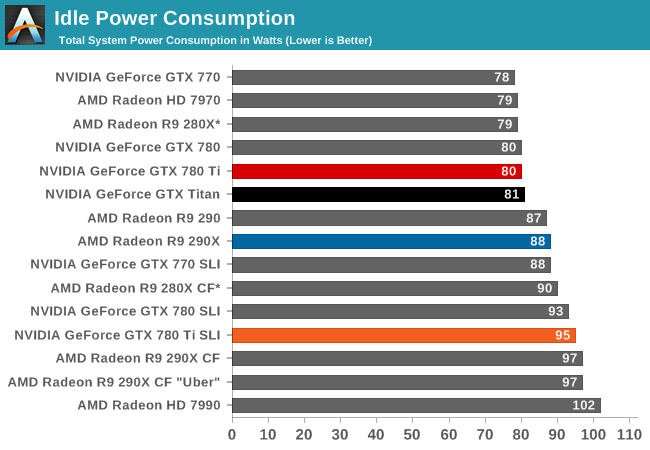
With all of our GK110 cards sharing a common design, at idle there’s very little to differentiate them. Other than GTX Titan’s extra 3GB of VRAM, we’re essentially looking at identical cards when idling.
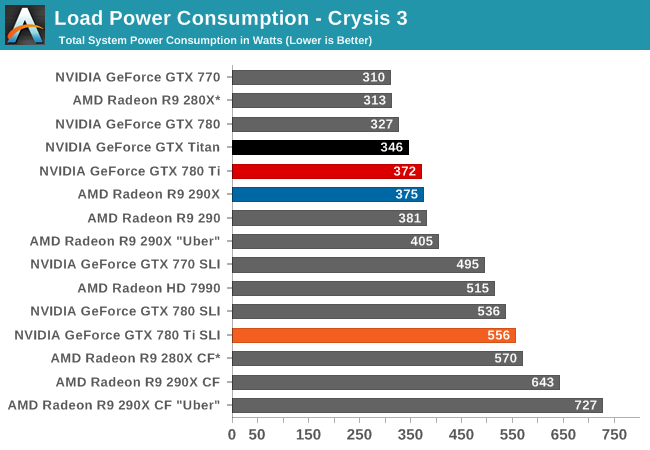
Moving on to load power, we can see the power/heat ramifications of the slight clockspeed increase coupled with the activation of the 15th SMX. Even with the further optimizations NVIDIA has put into the new revision of GK110, power consumption has gone up in accordance with the higher performance of the card, just as we’d expect. Since NVIDIA doesn’t notably alter their power efficiency here, that increased performance has to come at the cost of increased power consumption. Though in this benchmark it’s worth pointing out that we’re measuring from the wall and that GTX 780 Ti outperforms GTX Titan by 8%, so some of that 29W power difference will come from the higher CPU load caused by the increased framerates.
As for the GTX 780 Ti SLI, here we see power level off at 556W, 20W more than the GTX 780 SLI. Some (if not most) of that is going to be explained by the increased CPU power consumption from the GTX 780 Ti SLI’s higher framerates. Coupled with that is the fact that in SLI setups these cards get hotter, and hence have to downclock a bit more to maintain equilibrium, which helps to offset the increased power requirements of GTX 780 Ti and keep the SLI results so close to the GTX 780 SLI results.
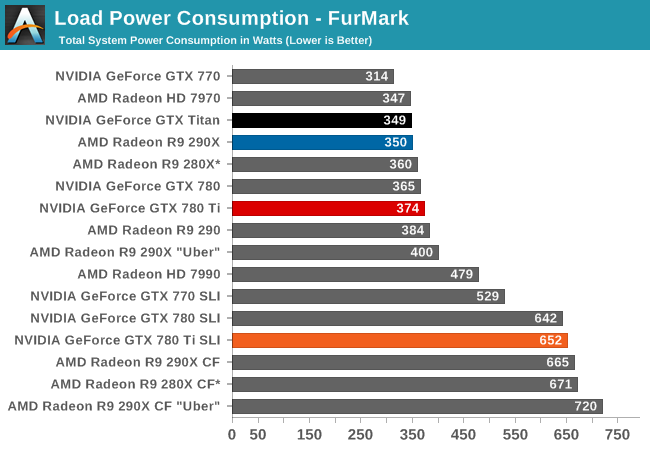
Switching over to FurMark, we find that power consumption is also up, but only slightly. With GPU Boost 2.0 clamping down on power consumption all of our GK110 cards should be clamped at 250W here, and with a difference between GTX 780 and GTX 780 Ti of under 10W, that’s exactly what appears to be happening here.
On a side note, it’s interesting to note here that under FurMark we’re seeing the GTX 780 Ti draw more power than the Radeon R9 290X. Despite the fact that the 290X has a higher rated TDP, in the card’s default quiet mode the card can’t actually dissipate as much heat (and thereby consume as much power) as the GTX 780 Ti can.
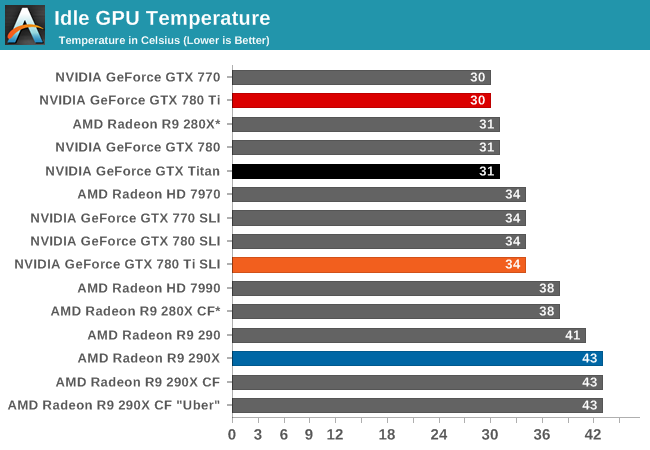
For idle temperatures we’re once again looking at cards that are for all intents and purposes identical. At 30C the GTX 780 Ti easily stays nice and cool.
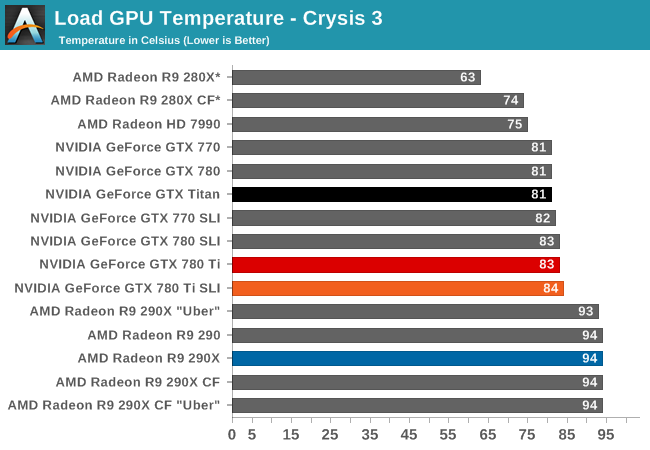
As we mentioned in our look at the GTX 780 Ti hardware, NVIDIA has increased their default temperature throttle point from 80C on the GTX Titan/780 to 83C on the GTX 780 Ti. The end result is that in all of our temperature limited tests the GTX 780 Ti will peak at 83C-84C, whereas the older GK110 cards will peak at 80C-81C.

FurMark reiterates what we saw with Crysis 3. The temps are up a bit across the board, while the GK110 cards are holding near their throttle points. The SLI setups meanwhile approach the upper-80s at 88C, reflecting the fact that even with blowers, there’s some impact on neighboring cards in high load situations.
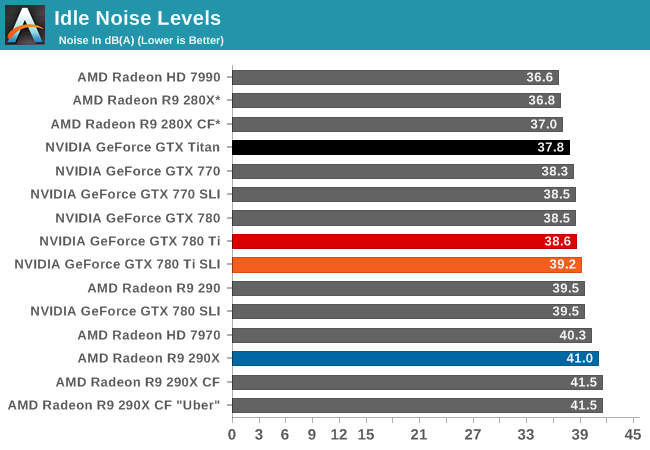
Our last idle scenario, we once again see all of our GK110 cards performing similarly, with idle noise levels in the 38dB-39dB range.
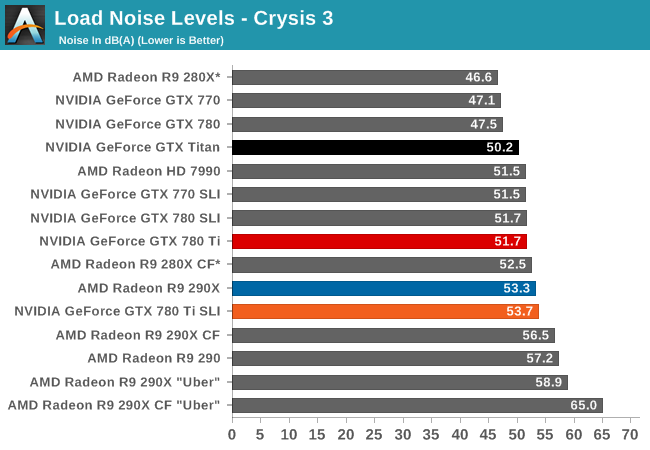
Moving on to our gaming load noise results, we can see the full repercussions of the GTX 780 Ti’s higher average power consumption coupled with the card’s higher temperature throttle point. Moving the throttle point along the same curve has the end result of moving higher the equilibrium point and thereby the card’s operating noise levels. As the fastest single-GPU card on this card, the GTX 780 Ti is still doing very well for itself and for a blower based design at 51.7dB, though at 1.5dB louder than GTX Titan and 4.2dB louder than GTX 780 the noise tradeoff for the card’s higher performance is very clear. Meanwhile the fact that it’s tied with the GTX 780 SLI comes with its own bit of irony.
Speaking of the GTX 780 SLI, we can see the noise impact of SLI configurations too. The GTX 780 Ti SLI levels out at 53.7dB, 2dB louder than our single-card configuration and 2dB louder than the GTX 780 SLI. At this point it’s just a bit louder than the 290X and quieter than a number of other 290 series setups.
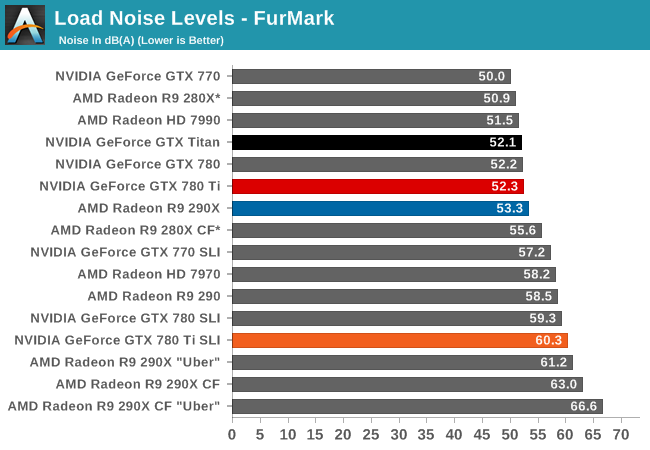
Finally with load noise levels under FurMark we can see where our various cards will peak at for noise levels. The GTX 780 Ti creeps up to 52.3dB, essentially tying with the GTX 780 and GTX Titan. Otherwise it comes in just behind the 290X, and the start of the pack for our multi-GPU setups.
As for the GTX 780 Ti SLI, like our single-card comparison points its up slightly as compared to the GTX 780 SLI.
Overall, our look at power, temperatures, and noise has been a rather straightforward validation of our earlier suspicions. GTX 780 Ti’s higher performance leads to higher power consumption, and will all other factors being held equal – including the cooler – power, temps, and noise levels all rise a bit as compared to GTX Titan and GTX 780. There’s no such thing as a free lunch here, and while GPU Boost 2.0 will keep the maximum levels suitably in check, on average GTX 780 Ti is going to be a bit worse than the other GK110 cards due to those factors. Though even with the increased noise levels in particular, GTX 780 Ti is still able to outperform 290X on noise while also delivering better gaming performance, which makes this another tidy victory for NVIDIA.










302 Comments
View All Comments
Kutark - Friday, November 8, 2013 - link
The argument was never whether one or the other was a better value but rather which is the better card. Thats what this discussion is about. Anybody with their head not firmly planted in their ass can see the 290x is a good value. The problem is value changes from person to person. Some people don't care how noisy their video card is. Some people don't care how hot it runs under load. Those people would find that card to be an excellent value. Other people do care. For them it might be worth it to pay extra for a quieter card that runs 8-10c cooler. Just like some people don't give 2 shits about having leather seats in their car, and don't think a $2000 option for leather would be a good value. Others think its great.Secondly, the Ti only loses to the 290x at 4k resolution which is a complete non point as there is all of 1 4k monitor out right now and it costs 2x of what most people spend on their computer. Lets not also mention that to get decent framerates you need a minimum of 2x of the 780/Ti's or the 290/Xs, So we're talking about a 5k investment outside of the rest of your shit to play at 4k? Id be willing to bet less than 1 in million PC gamers have that much money into their rigs
Mondozai - Friday, December 13, 2013 - link
AMD fucked up with their reference cooler, and they fucked up with not providing data early enough to OEMs for aftermarket coolers. But comparing stock 290/290X to the GTX 780 Ti is misleading. You have to compare both cards when there are aftermarket coolers to both of them.But you don't do that. Why? Because you know an aftermarket cooler isn't going to be a big difference to 780 Ti, but it will make a massive difference to 290/290X.
Stock versions of both cards with aftermarket cooler from the same OEM will show very little variance in performance at higher(1440p and above) resolutions. Except that 780 Ti will remain completely overpriced.
Price to performance ratio isn't just about budget and middle segment cards. You can do the same to high-end cards. A 290X with an aftermarket cooler is simply going to beat out 780 Ti in anybody's but a fanboy's eyes. Sorry, but you're fanboying.
And I am saying that as an Nvidia card owner myself, but the fact remains that Nvidia has been able to rape the wallets of a lot of people for so long, and I blame AMD for this, that some people like you have internalized the raping and come to defend it.
I can only look at you with pity.
Owls - Thursday, November 7, 2013 - link
Ryan I'm sorry but the video card reviews as of late have been very poor in quality and objectivity. Stop rushing to be the first. I don't go to Anand to read a crappy review, that's what HardOCP is for.That said your testing is flawed with old games and comparing the Ti to be faster than a 290x that is in silent mode is disingenuous. We all expect better from this site.
ol1bit - Thursday, November 7, 2013 - link
First, Fantastic Review as always!As a side note, it's amazing to me that AMD can't get the performance with the same heat output as Nivida. After all they are a semi-big chip company, what gives?
FuriousPop - Thursday, November 7, 2013 - link
wow! as a current AMD owner, i must say it is impressive. Temps and noise great! - power consumption not as much as expected, but hey a good card indeed. Now if only we could see the benchmarks in the higher areas of 1600p+. If your going to make a comment of overkill at 1440p with SLi of these, then why not show 1600p then and see how it really matches up!?i know that it in the past has been AMD for >1440p and Nvid for 1080< but as of late, we are starting to see that change dramatically.
Can we please see some 1600p and 1600p+ res being tested on benchmarks! if there were already those benchmarks out and showed impressive results at higher resos i prob would of gone out and bought 2x of these ASAP. however will have to wait and see...
AnotherGuy - Thursday, November 7, 2013 - link
So Ryan, you made the R9 290 as a total disappointment because it had a little higher noise than the rest at the time, but now when you see the 780 getting close at 52dB this is a little high but ok for nVidia and they won...That is not fair.You need to control those emotions, think many times and then finally find the right words to describe a product, not let your first thought into the final conclusion of a review.
Ma Deuce - Thursday, November 7, 2013 - link
You need to control those emotions. Think many times and then finally find the right words to criticize a review, not let your first thought into the comment...290 is loud and hot and he didn't recommend it. Sorry man, it's not the end of the world though. You can buy it without their expressed written consent.
sf101 - Friday, November 8, 2013 - link
Anotherguy your right though on the 290x review they made it sound like the end of the world over the noise /temp and power use levels.Yet when Nvidia does it its ok.
And everyone just does a point in other direction look its super man type thing and pretends it didn't happen.
If your going to be nit picky about noise and heat then at-least be consistent from what I've seen both the 290 and 780ti are fairly close in wattage use now so there goes your TDP arguments.
And just because Nvidia has a better reference cooler doesn't change the fact that it still is using similar wattage to the 290/290x the only difference is Nvidia's cooler deals with it a bit better.
just finding the review a tad bias ,,,,,,,
Morawka - Friday, November 8, 2013 - link
the 290 got up to 62 dbformulav8 - Monday, November 11, 2013 - link
Ryan's reviews has stunk for awhile now. I used to defend him and anand on appearing bias and such. But there does seem to be something. And the thing is that if it is true, they could care less. Literally